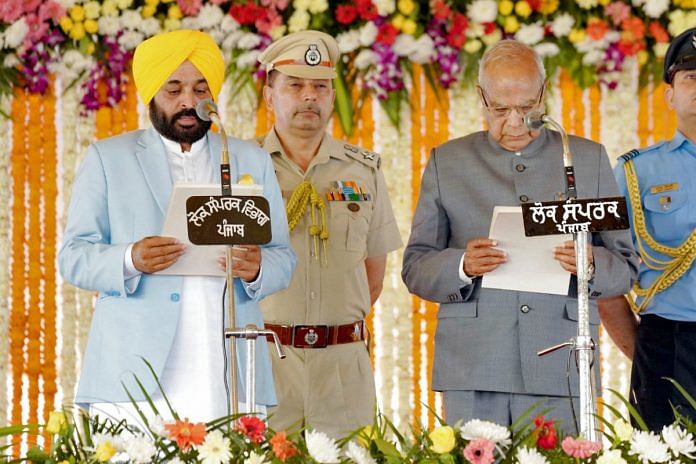New Delhi: The Supreme Court Tuesday pulled up both Punjab Chief Minister Bhagwant Mann and Governor Banwarilal Purohit for their confrontation over summoning the state assembly.
A bench comprising Chief Justice of India D.Y. Chandrachud and Justice P.S. Narasimha asserted that the level of discourse between a chief minister and a governor must not degenerate into a “race to the bottom”.
The court was hearing a petition filed by the Punjab government over Purohit’s refusal to summon the assembly. The row between the duo had worsened last month, when Purohit told Mann that he would decide on summoning the assembly for the budget session only after taking legal advice on an “unconstitutional and derogatory” tweet and letter from the CM.
On 13 February, Purohit had written a letter asking Mann to explain the process of selecting 36 government school principals for a training seminar held in Singapore that month, saying he had received complaints about “malpractices and illegalities”.
However, Mann then took to Twitter to say that he was answerable only to three crore Punjabis, not to a governor appointed by the central government. On 14 February, Mann also sent a written response, questioning the criteria adopted by the Union government for the appointment of governors.
While responding to the state cabinet’s decision to convene the budget session, Purohit had called Mann’s tweets and letter “not only patently unconstitutional, but extremely derogatory”. The Punjab government then approached the Supreme Court.
What does the Constitution say about the governor’s power to summon the House? And what happened during the hearing in the Punjab case? ThePrint explains.
Also Read: Tamil Nadu vs Tamizhagam — Governor Ravi stirs up political storm in DMK-ruled state
What does the Constitution say?
Article 174 of the Constitution empowers a governor to summon the House of the legislature to “meet at such time and place as he thinks fit”.
Article 163 requires the governor to act on the “aid and advice” of the council of ministers, headed by the chief minister of the state. However, it adds that the governor would not need this aid and advice if the Constitution requires him to carry out any function at his discretion.
The two provisions are usually read together to outline the powers of governors to summon the House under Article 174.
Additionally, Article 167 makes it the duty of the chief minister to communicate to the governor “all decisions of the council of ministers relating to the administration of the affairs of the state and proposals for legislation”. It also makes the chief minister duty-bound to furnish any information the governor may demand on administrative affairs and proposals for legislation.
What courts have said
In a landmark 2016 judgment in the Nabam Rebia case, the Supreme Court had ruled that “the governor can summon, prorogue and dissolve the House only on the aid and advice of the council of ministers with the chief minister as the head. And not at his own.”
This judgment arose out of a constitutional crisis that occurred in Arunachal Pradesh in 2015-16. Nabam Rebia, then the Speaker of the Arunachal Pradesh assembly, had approached the top court after the state’s governor brought forward an assembly session on a joint request by 13 MLAs (11 from the Bharatiya Janata Party and 2 Independents). These MLAs had also issued a notice of resolution for the removal of Rebia from the Speaker’s post.
The matter reached the Supreme Court, which ruled in 2016 that ordinarily the governor can summon the House only on the aid and advice of the council of ministers, headed by the chief minister.
However, the court had clarified that if the governor had reason to believe the CM and council of ministers had lost the confidence of the House, he could ask them to prove their majority by a floor test.
‘Dereliction of duty’
The Supreme Court had agreed Tuesday morning to grant an urgent hearing on the Punjab government’s petition against Purohit’s refusal to summon the assembly for the budget session from 3 March. However, when the petition was taken up at 3.50 pm, Solicitor General Tushar Mehta informed the court that the governor had now summoned the House on that date.
The court then rapped both the Punjab government and Purohit for their actions. It pointed out that Article 167 allows the governor to seek information from the government, and the government is duty bound to provide such information. At the same time, the bench added that the governor is also bound by the cabinet’s advice to summon the session.
“From both sides there is a dereliction,” Justice Narasimha was then quoted as saying.
Justice Chandrachud also emphasised the need to have a “constitutional discourse”, adding, “We may belong to different political parties, of course the governor is to be above politics.”
The court then referred to precedents, including the Nabam Rebia case, and pointed out that the governor’s powers under Article 174 have to be exercised in accordance with the aid and advice of the council of ministers.
It also asserted that the tone and tenor of Mann’s letter “leaves much to be desired”, but added that the “dereliction of the chief minister” is not a justification for the governor to refrain from summoning the House in accordance with the constitutional provision.
The court advised that constitutional dialogue between the functionaries should be done with “matured statesmanship”, and said, “Political differences in a democratic polity are acceptable and have to be worked out with a sense of sobriety and maturity without allowing the discourse to become a race to the bottom.”
(Edited by Geethalakshmi Ramanathan)
Also Read: Governor vs govt not new in India but Constitution doesn’t guarantee a solution



